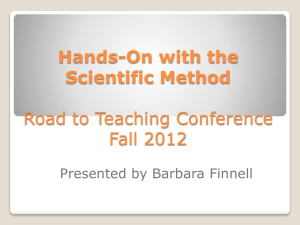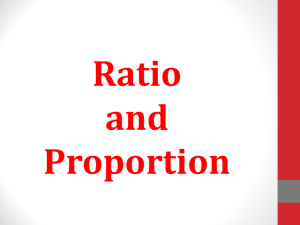Probability of a single event
advertisement
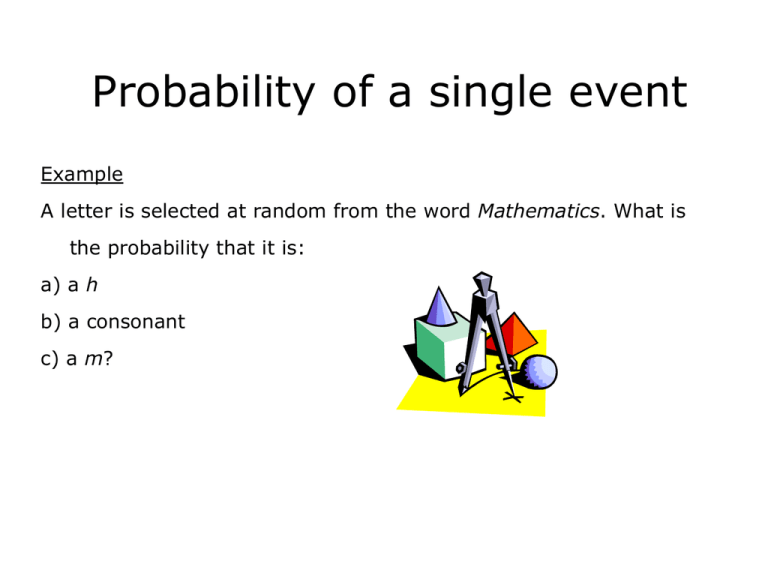
Probability of a single event Example A letter is selected at random from the word Mathematics. What is the probability that it is: a) a h b) a consonant c) a m? Example A bag contains 9 white balls, 8 green balls and 3 blue balls. One ball is selected at random. What is the probability that the ball is (a) white (b) green (c) red (d) not blue? Example A single card is drawn from a pack of 52 playing cards. Find the probability of the card being: (a) a Queen (b) a club (c) the Jack of hearts (d) an even number. (e) a picture card Example 26% of the population is overweight. What is the probability that a person selected at random is not overweight? Example Ten counters equal in size and shape are numbered 1, 2, 3, 4, 5, 6, 7, 8, 9 and 10 are placed in a bag. One counter is selected at random. What is the probability of selecting a counter which is (a) numbered 3 (b) a factor of 16 (c) greater than 7? Example The table below shows the distribution of the ages of people visiting a local dentist in the month of March. Age (n) frequency 0 n 15 15 n 30 30 n 45 45 n 60 60 n 75 54 38 25 40 17 A person is selected at random to answer a survey. What is the probability that the person is aged between 15 and 30 years of age. Example The Bar chart below represents the favourite subjects of class 6B1. 10 8 6 4 2 0 History Maths English Science French Art One student is selected at random. What is the probability that their favourite lesson is mathematics? Example A bag contains blue, red and green cards only. One card is taken at random from the bag. The table shows the probabilities of taking a blue card and a red card. Colour Blue Red Probability 0.3 0.5 Green (a) What is the probability of taking a yellow card from the bag? (b) What is the probability of taking a card that is not blue from the bag? (c) Complete the table to show the probability of taking a green card from the bag Example Emma has a box of counters. The counters are green, red or blue. She picks a counter at random. The table shows the probability that she picks a green counter and the probability that she picks a red counter. Colour Probability Green 0.6 Red 0.25 Blue (a) What is the probability that Emma picks a blue counter? (b) There are 10 red counters in the box. How many green counters are in the box? Relative Frequency Example A spinner with five edges numbered 1 to 5 is spun 20 times and the results are shown below. 1 4 3 3 4 5 1 2 1 3 4 5 1 3 4 2 2 1 5 4 Complete the table of relative frequencies below. Number on spinner Relative Frequency 1 2 3 4 5 Example The Bumbleton and Stickton village football teams have played each other 50 times. Bumbleton have won 10 times, Stickton have won 35 times, and the teams have drawn 5 times. Estimate the probability that Stickton will win the next match Example Matthew decides to try to estimate the probability that toast lands butter-side-down when dropped. He drops a piece of buttered toast 50 times and observes that it lands butter-side-down 30 times. Estimate the probability that the toast lands butter-side-down. Example A drawing pin can land 'point up' or 'point down' when dropped. Jim drops a drawing pin 100 times and it lands "point up" 35 times. Estimate the probability of the drawing-pin landing "point up" Example A spinner has a red sector (R) and a yellow sector (Y). The arrow is spun 1000 times. The table shows the relative frequency of a red after different numbers of spins. Red Yellow Number of spins Relative frequency of a red 50 0.42 100 0.36 200 0.34 500 0.3 1000 0.32 a) How many times was a red obtained after 200 spins? b) Which relative frequency gives the best estimate of the probability of a red? Explain your answer. Example A dice is suspected of bias. Here are the results of 20 throws 3 4 2 3 1 5 6 2 4 3 4 3 1 1 6 2 5 6 5 3 (a) Use these results to calculate the relative frequency of each score Score 1 2 3 4 5 6 Relative frequency (b) Use the relative frequency to calculate how many times you would expect to score 3 in 60 throws of this dice. (c) Compare your answer to part (b) with the number of times you would expect to score 3 in 60 throws of a fair dice.
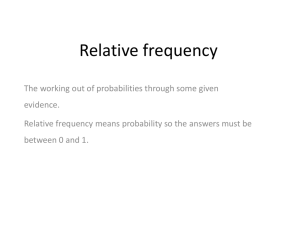
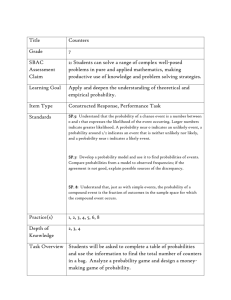



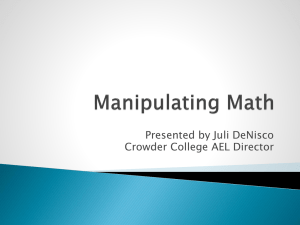
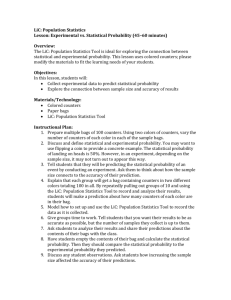
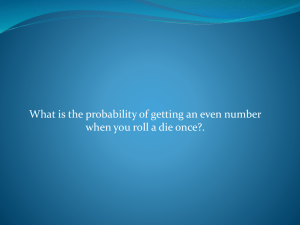
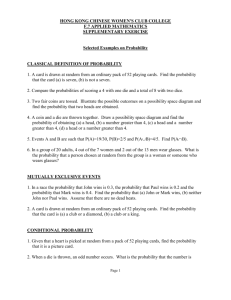
![Lesson 8_3–Synchronous Counters[1]](http://s2.studylib.net/store/data/005727557_1-25e5d6e99f500ad17373ec48380a1b3c-300x300.png)
